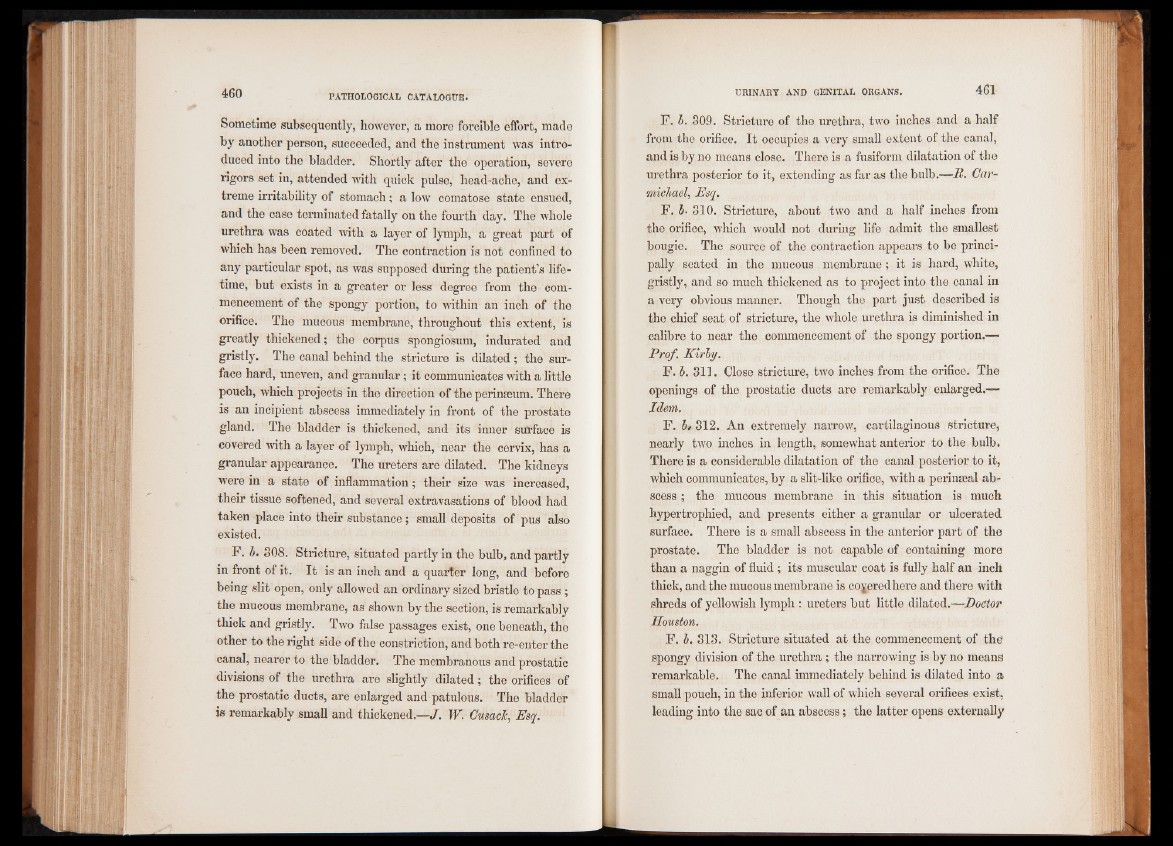
Sometime subsequently, however, a more forcible effort, made
by another person, succeeded, and the instrument was introduced
into the bladder. Shortly after the operation, severe
rigors set in, attended with quick pulse, head-ache, and extreme
irritability of stomach; a low comatose state ensued,
and the case terminated fatally on the fourth day. The whole
urethra was coated with a layer of lymph, a great part of
which has been removed. The contraction is not confined to
any particular spot, as was supposed during the patient’s lifetime,
but exists in a greater or less degree from the commencement
of the spongy portion, to within an inch of the
orifice. The mucous membrane, throughout this extent, is
greatly thickened; the corpus spongiosum, indurated and
gristly. The canal behind the stricture is dilated ; the surface
hard, uneven, and granular; it communicates with a little
pouch, which projects in the direction of the perinseum. There
is an incipient abscess immediately in front of the prostate
gland. The bladder is thickened, and its inner surface is
covered with a layer of lymph, which, near the cervix, has a
granular appearance. The ureters are dilated. The kidneys
were in a state of inflammation; their size was increased,
their tissue softened, and several extravasations of blood had
taken place into their substance; small deposits of pus also
existed.
F. b. 308. Stricture, situated partly in the bulb, and partly
in front of it. 'It is an inch and a quarter long, and before
being slit open, only allowed an ordinary sized bristle to pass;
the mucous membrane, as shown by the section, is remarkably
thick and gristly. Two false passages exist, one beneath, the
other to the right side of the constriction, and both re-enter the
canal, nearer to the bladder. The membranous and prostatic
divisions of the urethra are slightly dilated; the orifices of
the prostatic ducts, are enlarged and patulous. The bladder
is remarkably small and thickened.—/. W. Cusack, Esq.
F. b. 309. Stricture of the urethra, two inches and a half
from the orifice. It occupies a very small extent of the canal,
and is by no means close. There is a fusiform dilatation of the
urethra posterior to it, extending as far as the bulb.—B. Carmichael,
Esq.
F. b. 310. Stricture, about two and a half inches from
the orifice, which would not during life admit the smallest
bougie. The source of the contraction appears to be principally
seated in the mucous membrane; it is hard, white,
gristly, and so much thickened as to project into the canal in
a very obvious manner. Though the part just described is
the chief seat of stricture, the whole urethra is diminished in
calibre to near the commencement of the spongy portion.—
Prof. Kirby.
F. b. 311. Close stricture, two inches from the orifice. The
openings of the prostatic ducts are remarkably enlarged.—
Idem.
F. b. 312. An extremely narrow, cartilaginous stricture,
nearly two inches in length, somewhat anterior to the bulb.
There is a considerable dilatation of the canal posterior to it,
which communicates, by a slit-like orifice, with a perinseal abscess
; the mucous membrane in this situation is much
hypertrophied, and presents either a granular or ulcerated
surface. There is a small abscess in the anterior part of the
prostate. The bladder is not capable of containing more
than a naggin of fluid; its muscular coat is fully half an inch
thick, and the mucous membrane is covered here and there with
shreds of yellowish lymph : ureters but little dilated.—Doctor
Houston.
F. b. 313. Stricture situated at the commencement of the
spongy division of the urethra ; the narrowing is by no means
remarkable. The canal immediately behind is dilated into a
small pouch, in the inferior wall of which several orifices exist,
leading into the sac of an abscess; the latter opens externally